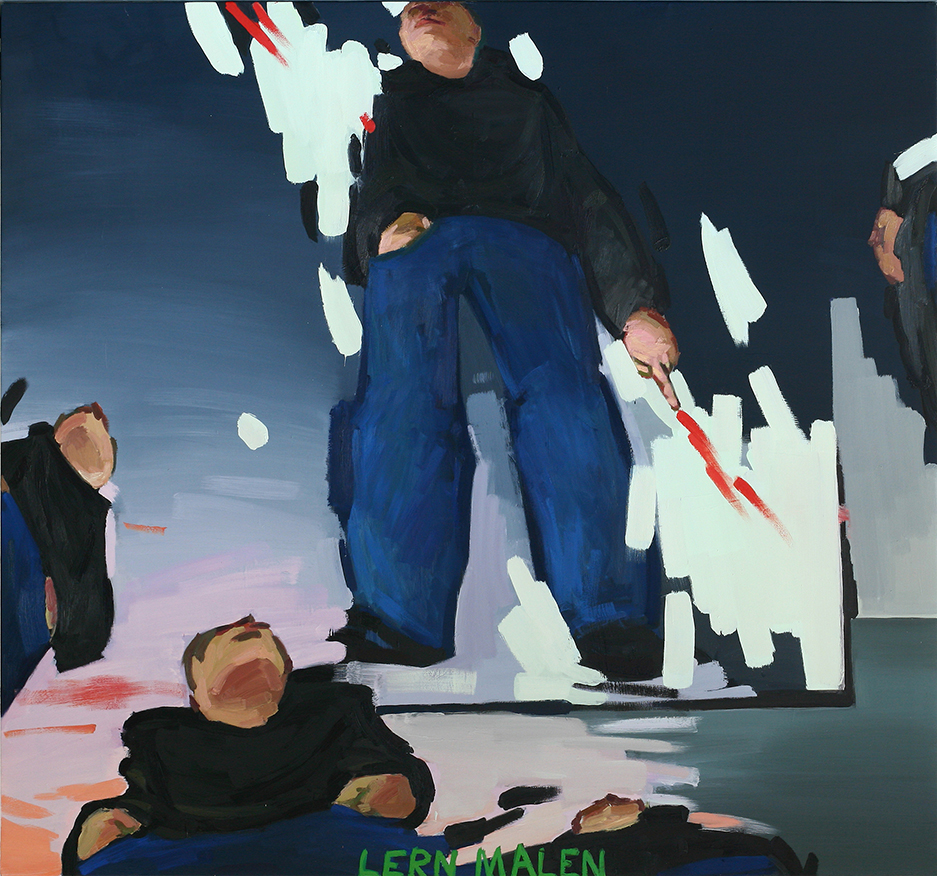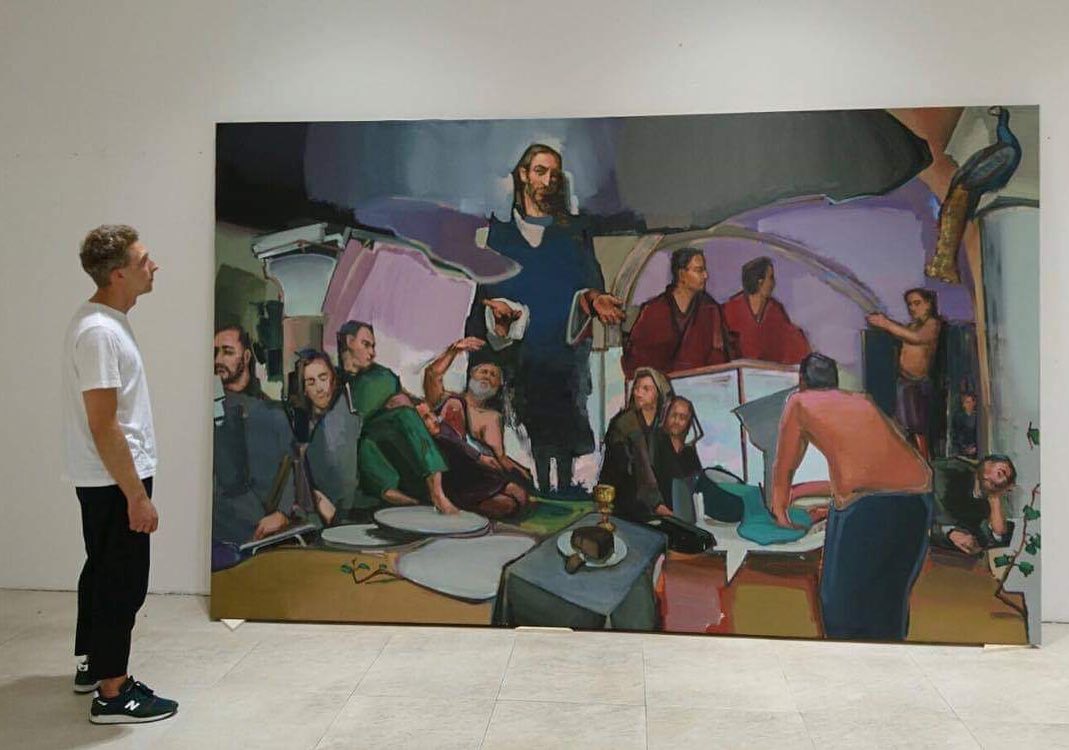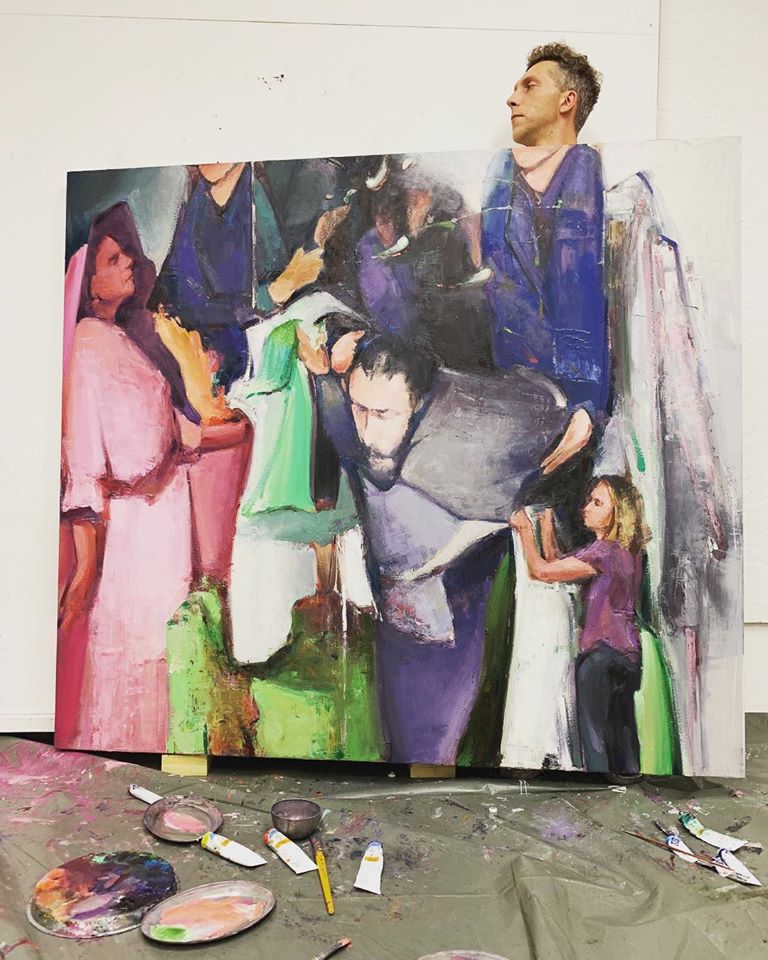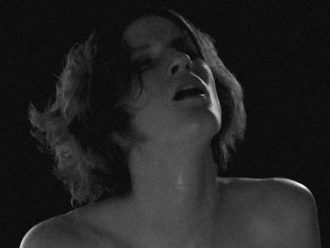Andrius Zakarauskas (b. 1982) is a painter, one of the most notable names and faces of the Lithuanian art scene. His artworks are characterised by deep colour palettes, multi-figure and multi-plane compositions, the consistent development of subjects that centre on the relationship between painting and the painter, the birth of an image and the result of that relationship. Zakarauskas is productive and actively exhibiting locally and, in recent years, often internationally. That is why the interview we had already planned for some time happened after the pandemic and quarantine saw the closure of museums, galleries, cultural and educational institutions and loosened otherwise tight timetables of cultural life. The talk, however, centred more on topics that are not as easily affected by the changes of public life.
Justina Augustytė: I was wondering, how to introduce you when the stock phrase “younger generation painter” no longer suits you anymore? You have outgrown the category.
Andrius Zakarauskas: I usually introduce myself simply as a painter; this word describes my way of seeing and thinking. It is not influenced by time. Although today, I still feel young and this boundary recedes every year.
JA: What about nationality? What is your relation to Lithuanian painting, its history or the so-called “Lithuanian school of painting”?
AZ: I have always seen myself as part of this tradition. I wanted to continue it and to be recognised as a Lithuanian painter. Since my studies, I have analysed artists of “Ars” group and Lithuanian modernism in general. I have a strong feeling to continue doing that. References to particular painters and their works, even their painting styles are important to me. For example, I was impressed by Viktoras Vizgirda and the landscapes he painted, their rich colour palettes and dynamic brushwork. I would also mention personal pop art by Kostas Dereškevičius; I admire his careful, but at the same time, very determined brushstroke, and his ability to combine text and other signs with figures. I probably mostly refer to subjects painted by Jonas Gasiūnas. His flame-painted army helicopters “Apache” reappears in my painting “Judgement Day”. We also painted a picture together. By the way, I once had an unrealised idea to finish a painting by Vladas Karatajus. I wanted to buy a landscape by this social realist artist and finish it sensitively and respectfully in my own way, in the way I see it.
JA: What other influences could you mention being significant either now or earlier?
AZ: Influences are and were surrounding me all the time. I either give in to them, or confront them. My teachers and friends I studied with determined my early influences. While studying, I turned to subtle palettes of greys, which were inspired by television and photography – it was my way to oppose rich colours I found were dominant in painting. I was looking for new contexts I could talk within. I cannot forget the words told to me once by my drawing teacher Gintaras Makarevičius: “You are so uninteresting, go and flip through magazines to see what is happening in the world.” I did not see what was happening in galleries all over the world and was not interested in that. But that spurred me into visiting a library. Later, after finishing my studies, I called this “references” and not influences. Nowadays, adventures in life, everyday experiences, and personal insights affect my painting more.

Photo from Andrius Zakarauskas‘ archive.
JA: What are your artistic authorities or do you refuse to have any authorities over you?
AZ: I don’t know if I could say I have any authorities, maybe they are figures I admire. These are changing constantly as I find new ones all the time. But, undoubtedly, they usually come from the art world. While studying, I admired my teachers Alfonsas Vilpišauskas and Laima Drazdauskaitė. Later, I became impressed by Jonas Gasiūnas and Arvydas Šaltenis. There are more artists whose works fascinate me like George Baselitz and Jonathan Meese. I don’t know why, but I feel closer to German artists. Their feeling and seeing of art often coincides with mine. German phrases (Lern Malen, Zu Ende) appear in my paintings, including earlier and new ones. It seems I can communicate more with German art, and Germans read my paintings more accurately. Overall, I think it is better not to meet artists you admire, not to know them. Then they remain special, different from other people. I love this illusion.
JA: Being a teacher yourself, how do you see this artistic authority issue from your perspective as a teacher?
AZ: I don’t want to become an authority over my students or to my students, I just try to share my way of seeing and help them create the images they want. I find this sharing of experience amusing, it is interesting to observe the ways creators of an even younger generation see their works. Now, during the quarantine, work with students became even more interesting. Their inventiveness and activeness surprised me. So sometimes it is quite good for them not to have a teacher looking over their shoulder.
JA: Do you ever reflect on the changes of your own work over time? Does looking at your earlier paintings become uncomfortable? Do you still recognise their author and is he still close to you?
AZ: I suppose I reflect intensively on what I have done. I even go through my childhood drawings often. I notice some elements, recurring in my artworks; they evolve, change, gain different interpretations. For example, around the time I was graduating from the academy, stories about this powerful personage or painter who paints an image about an image appeared in my works. I used to say it was painting about painting. The relation between a painter’s head and hand, manifested through brushstroke, was very important. The personage was kind of entering the artwork within the artwork. Sometimes his hand or head would work their way through the image of paint. Besides, I had to depict the movement of brushstrokes, so I used to multiply and repeat objects in the painting. These strategies are still visible in my works, only forms change slightly and new subjects emerge. By the way, my “Synonym of Remembrance” series and exhibition of the series are exactly about carrying this creative weight and efforts to get rid of it. In the end, I make every painting how I like. Keeping that in mind, I realise that I create every painting in the way I feel and manage at that time.

Lern malen-finale, 2008, oil on canvas., 180×200. Photo: Vidmantas Ilčiukas
JA: In the past, it seems the narrative within your work has almost been absent, but in recent artworks seems much more developed, would you say? The literary layer even manifests in direct text messages.
AZ: I would not say that narrative was completely absent in my painting. The story of painting and storytelling in symbols and references was always of great importance to me. It just reformed over time. A bigger shift was more in the dynamic of my painting. Today, I would say I returned to text more as an element of painting. I used text, e.g. Me or Lern Malen, in my work from 2007 to 2010. I had thoughts of not telling anything in my paintings, just applying paint and using it to create the space within canvas, but I quickly came back to narrative, almost naturally.
JA: Some of the subjects you take up – i.e. from religious and historic painting – are quite rare to see dealt with in contemporary painting. What is your relation to the tradition of these genres?
AZ: I liked a quote by one artist that said “every painting is religious,” I just cannot remember who said it. I think about this often. It just happened that religion with its entire artistic load found me. I am interested in it more and more. I understand that religious subject matter is usually thought to be characteristic to later creative periods of an artist, but in my case, it was essential and I had no choice.
I try to express a very personal perspective on biblical stories, sometimes even taking them far away from the written truth. Of course, I go deep into earlier paintings in search of references and comments for my own work. Sometimes I paint recognised figures that have their own iconographic tradition, if I need specificity, so that it is clearly St. John the Baptist or St. Peter. Once in the museum in Vienna, I saw a baroque painting of a woman holding a plate with a man’s head on it. It was a classic popular scene, lodged in the history of art for ages, depicting the story of St. John the Baptist and Salome. Salome was painted in baroque attire, not in first century clothing. This minor observation gave me an absolute freedom to paint biblical figures my own way. I realised I could depict the meanness of humanity, how it manifests today.

Photo from Andrius Zakarauskas‘ archive.
JA: How many autobiographical details appear in your paintings intentionally and deliberately?
AZ: The images I create relate to everyday situations, not necessarily directly, more metaphorically. Sometimes portraits of the personages bear my features or my wife’s. A personage has to have a face, so I often paint familiar faces despite telling other people’s stories with them. For instance, my wife performs the role of Veronica in the painting of the Sixth Station of the Cross. Naturally, many of the painted figures often resemble me. But this is not a rule. This is just how I make subjects more personal, I experience them more intensively, they become closer to me. That way I can apply those great biblical stories to my life.
JA: Being that the narratives of your paintings are often complex and multifaceted, is it important for you that your viewer reads them according to your original idea or close to it, at least?
AZ: The complexity and ambiguousness of a narrative is intentional, but its message depends on the viewer – the reader of an image. Emotion or feeling evoked by an image, or transmitted through it, is the first and the most important thing. Then, it becomes akin to walking in the forest: the deeper into the forest, the more firewood. The difference is that you cannot get lost in the painting like you can in the woods, so just enjoy the image. Alternatively, you may not enter the forest at all. Of course, it is important that a viewer would decipher as many contexts and references as possible. However, I do not want to overload my viewers with unclear information. More often, I just want to leave some unanswerable questions.
JA: You exhibit your works abroad a lot with recent solo shows in China and Germany. How have the local art publics perceived your work in those countries, and what are the differences between them?
AZ: When abroad, I am always impressed by how great interest there is in culture in general. People are actively attending a diversity of cultural events, not just art exhibitions. During my exhibition openings, I like talking to visitors. They ask questions and often surprise me with their interpretations of my works. I remember in China, the paintings that were difficult for a Lithuanian public to read had so much more recognition there. In Germany, great attention is paid to an artist and their artworks. They appreciate talent there and you immediately feel respected. I am glad that in Lithuania, more and more people are gradually visiting art exhibitions – they used to be kind of closed circle events.
JA: I recently read a sentiment of one artist that said “a finished painting is a dead painting.” Is feedback therefore important to you, and are you interested in the lives your paintings and their stories have after you release them?
AZ: Yes, I have heard similar declarations and different variations of that thought. When I paint in my study, I say to myself “finished”, “I finished the painting”. But this is relative. A painting does not exist for its own sake. The environment and time affect it. Even when I change its settings, for example, I transfer it to an exhibition space, it changes again. During my last exhibition “Stories from Before” at The Rooster Gallery I wanted to transform finished paintings. I renewed them by giving them different forms and employed the exhibition architecture to assist. Another way to give painting a different life or to extend it is to place it in a group show. Surrounded by other artists’ work it acquires new contexts. A painting even accumulates another set of meanings displayed in a church. Therefore, paintings live while they are important to me or anybody else.
JA: In this exhibition you just mentioned, “Stories from Before,” your paintings literally climbed off the walls and were exhibited like three-dimensional objects. Did you feel like plane surfaces were restricting you?
AZ: I explain my work as a construction of space on the plane. In order to generate more ways to look at the paintings adding different meanings to them, I created additional surfaces in the exhibition space. I wanted every painting to become parts of one bigger artwork, and the exhibition to become a whole, one installation of objects. I created special backgrounds, even a separate wall for paintings, and displayed one canvas on a mobile construction. I wanted to turn that painting into a sculptural object. A new story appeared when I hung the painting on its own reproduction, the illusion grew deeper. This way of creating new spatial effects by layering print under painting with the same image was very new to me. I was genuinely happy when a friend told me that he had never seen anything like it before.

Andrius Zakarauskas, Stories From Before, exhibition view, Rooster Gallery, 2020, Photo: Artland installation photography

Andrius Zakarauskas, Stories From Before, exhibition view, Rooster Gallery, 2020, Photo: Artland installation photography
JA: Are you interested in experimenting with other media or not?
AZ: Painting is not an exhausted medium for me. It is my means of seeing and thinking. I do not think of it as a medium I would like to replace. Instead, I think about shapes that I could use to tell things, to communicate with viewers. And all the other media is subjected to reaching the result I want. One of the recent memorable examples of my relationship to other media was winning the “Instant Instax” prized contest organised by press photographers in 2019.
JA: What do you find most relevant in painting these days?
AZ: I prefer conceptual image making. Every means of expression carries the information, transmits references and opens contexts. Even brushstrokes of oil paint become a subject; I often emphasise its importance in the title of a painting. Thus the moment that still interests me most is the emergence of an image. It is like a miracle – the image appearing to touch the surface, and the emotions it emanates. Currently, my main goal is for the artwork to convey ironic anger, but with melancholy, love and subtlety, though I do not search for anything in particular while painting. That’s just the way it is today, the way it was and the way it will always be.
JA: Do you think that contemporary art (of course including contemporary painting) is relevant to the extent that it reflects the present moment?
AZ: The present moment is very important in creative work, but it undoubtedly has to have a connection to the past and also be directed towards the future. Yet, suggestiveness of an artwork is more important than its topicality. My main goal today is to reveal the full spectrum of feelings and emotions when creating an image. I try to do that through certain narrative situations and formal decisions, and to “dress” all this so it would look good for me. Once, a student asked me if it was possible not to tell anything through an artwork. I think it is impossible, but would make for an interesting challenge.
JA: The unusual times we are finding ourselves living in. How have the pandemic and quarantine restrictions affected your mood, creative routine and output?
AZ: The work in the studio stopped during the quarantine. My wife and I retreated to Palanga. I only had some paper and a pencil resulting in a new series of drawings to be born quite quickly. I still have to develop it, thinking about its final view. This was the result of the present and general emotional charge, reaching us by way of TV reports and through social media. I wanted to convey dominant emotions – fair, uncertainty, concern, and so on. I placed tones in pencil hatches, trying to find my own ways of formal construction. I was drawing as if I stroke the paper, as if I somehow “combed” the emerging image. I added the texts “fear” and “the end” to enhance the feeling and describe the atmosphere. If anything, these tense times have boosted creativity despite my access to art supplies being limited. And so are the possibilities limited. But as I observe, I see artists are happy to be able to work peacefully. Only a few of them have been overwhelmed by any sense of fear. To conclude my thoughts and feelings around this, I don’t think that the pandemic will have a strong negative effect on art and culture in future but enhance and stimulate new creative experiences, and new story lines.

Photo from Andrius Zakarauskas‘ archive.

Photo from Andrius Zakarauskas‘ archive.

Photo from Andrius Zakarauskas‘ archive.

Run Stroke, 2020, pencil, paper, 84×59,4 (four parts)

Zu Ende stroke, 2020, pencil, paper, giclee print.

Synonym of remembrance (A), acrylic and oil on canvas, 160×175, 2015. Photo: Vidmantas Ilčiukas

Line, 2007, oil on canvas, 170×195. Photo: Vidmantas Ilčiukas
























